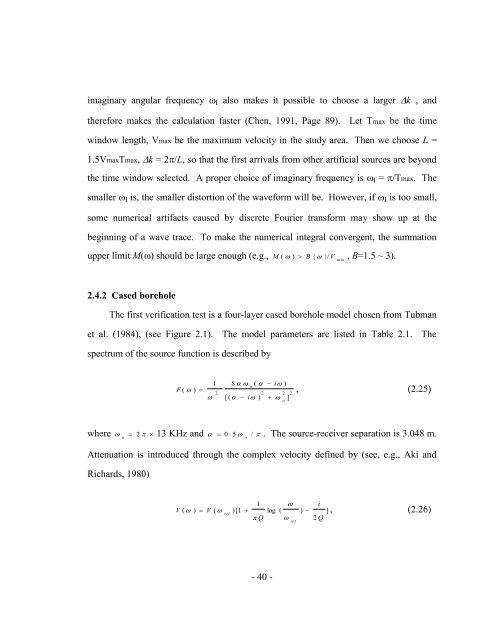My PhD Thesis, PDF 3MB - Stanford University
My PhD Thesis, PDF 3MB - Stanford University
My PhD Thesis, PDF 3MB - Stanford University
Create successful ePaper yourself
Turn your PDF publications into a flip-book with our unique Google optimized e-Paper software.
imaginary angular frequency I also makes it possible to choose a larger k , and<br />
therefore makes the calculation faster (Chen, 1991, Page 89). Let Tmax be the time<br />
window length, Vmax be the maximum velocity in the study area. Then we choose L =<br />
1.5VmaxTmax, k = 2/L, so that the first arrivals from other artificial sources are beyond<br />
the time window selected. A proper choice of imaginary frequency is I = /Tmax. The<br />
smaller I is, the smaller distortion of the waveform will be. However, if I is too small,<br />
some numerical artifacts caused by discrete Fourier transform may show up at the<br />
beginning of a wave trace. To make the numerical integral convergent, the summation<br />
upper limit M() should be large enough (e.g., M ( ) B | | / V m in , B=1.5 ~ 3).<br />
2.4.2 Cased borehole<br />
The first verification test is a four-layer cased borehole model chosen from Tubman<br />
et al. (1984), (see Figure 2.1). The model parameters are listed in Table 2.1. The<br />
spectrum of the source function is described by<br />
F ( ) <br />
1<br />
2<br />
8 o ( i )<br />
[ ( i ) 2<br />
- 40 -<br />
2<br />
] o<br />
2 , (2.25)<br />
where o 2 13 KHz and 0 . 5 o / The source-receiver separation is 3.048 m.<br />
Attenuation is introduced through the complex velocity defined by (see, e.g., Aki and<br />
Richards, 1980)<br />
V ( ) V ( re f )[1 <br />
1<br />
Q<br />
log ( <br />
re f<br />
) <br />
i<br />
2 Q<br />
] , (2.26)
















